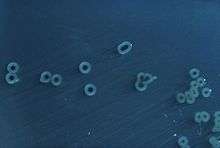Salmonella enterica
| Salmonella enterica | |
|---|---|
 | |
| S. enterica Typhimurium colonies on a Hektoen enteric agar plate | |
| Scientific classification | |
| Domain: | Bacteria |
| Kingdom: | Eubacteria |
| Phylum: | Proteobacteria |
| Class: | Gammaproteobacteria |
| Order: | Enterobacteriales |
| Family: | Enterobacteriaceae |
| Genus: | Salmonella |
| Species: | S. enterica |
| Binomial name | |
| Salmonella enterica (ex Kauffmann & Edwards 1952) Le Minor & Popoff 1987 | |
| Subspecies | |
|
S. enterica subsp. arizonae | |
Salmonella enterica (formerly Salmonella choleraesuis) is a rod-shaped, flagellated, facultative anaerobic, Gram-negative bacterium and a member of the genus Salmonella.[1] A number of its serovars are serious human pathogens.
Epidemiology
Most cases of salmonellosis are caused by food infected with S. enterica, which often infects cattle and poultry, though also other animals such as domestic cats[2] and hamsters[3] have also been shown to be sources of infection to humans. However, investigations of vacuum cleaner bags have shown that households can act as a reservoir of the bacterium; this is more likely if the household has contact with an infection source, for example members working with cattle or in a veterinary clinic.
Raw chicken eggs and goose eggs can harbor S. enterica, initially in the egg whites, although most eggs are not infected. As the egg ages at room temperature, the yolk membrane begins to break down and S. enterica can spread into the yolk. Refrigeration and freezing do not kill all the bacteria, but substantially slow or halt their growth. Pasteurizing and food irradiation are used to kill Salmonella for commercially produced foodstuffs containing raw eggs such as ice cream. Foods prepared in the home from raw eggs such as mayonnaise, cakes, and cookies can spread salmonella if not properly cooked before consumption.
Pathogenesis
Secreted proteins are of major importance for the pathogenesis of infectious diseases caused by Salmonella enterica. A remarkable large number of fimbrial and non-fimbrial adhesins are present in Salmonella, and mediate biofilm formation and contact to host cells. Secreted proteins are also involved in host cell invasion and intracellular proliferation, two hallmarks of Salmonella pathogenesis.[4]
Small non-coding RNA
Small non-protein coding RNAs (sRNA) are able to perform specific functions without being translated into proteins. 97 bacterial sRNAs from Salmonella Typhi were discovered by Chinni et al.[5]
AsdA (antisense RNA of dnaA) is a cis-encoded antisense RNA of dnaA described in Salmonella enterica server Typhi. It was discovered by deep sequencing and its transcription was confirmed by Northern blot and RACE analysis. AsdA, estimated to be about 540 nucleotides long, and represents the complementary strand to that encoding DnaA, a protein that plays a central role in the initiation of DNA replication and hence cellular division. In rich media, it is highly expressed only after reaching the stationary growth phase, but it under limiting iron or osmotic stress it is already expressed during exponential growth. Overexpression of AsdA stabilizes dnaA mRNA, increasing its levels and thereby enhance its rate of translation. This suggests that AsdA is a regulator of DNA replication.[6]
Nomenclature
Salmonella enterica has 7 subspecies, and each subspecies has associated serovars that differ by antigenic specificity.[7] There are over 2500 serovars for S. enterica.[8] Salmonella bongori was previously considered a subspecies of S. enterica, but it is now the other species in the Salmonella genus. Most of the human pathogenic Salmonella serovars belong to the enterica subspecies. These serogroups include Salmonella Typhi, Salmonella Enteritidis, Salmonella Paratyphi, Salmonella Typhimurium, and Salmonella Choleraesuis. The serovars can be designated as written in the previous sentence (capitalized and non-italicized following the genus), or as follows: "S. enterica subsp. enterica, serovar Typhi".
See also
- 1984 Rajneeshee bioterror attack
- AsrC small RNA
- Bacterial small RNA
- Contamination control
- HilD 3'UTR
- PinT small RNA
- Typhoid Mary
References
- ↑ Giannella RA (1996). Baron S; et al., eds. Salmonella. In: Baron's Medical Microbiology (4th ed.). Univ of Texas Medical Branch. ISBN 0-9631172-1-1. (via NCBI Bookshelf).
- ↑ Food Poisoning News
- ↑ Swanson SJ, Snider C, Braden CR, et al. (2007). "Multidrug-resistant Salmonella enterica serotype Typhimurium associated with pet rodents". New England Journal of Medicine. 356 (1): 21–28. PMID 17202452. doi:10.1056/NEJMoa060465.
- ↑ Hensel M (2009). "Secreted Proteins and Virulence in Salmonella enterica". Bacterial Secreted Proteins: Secretory Mechanisms and Role in Pathogenesis. Caister Academic Press. ISBN 978-1-904455-42-4.
- ↑ Chinni, Suresh V.; Raabe, Carsten A.; Zakaria, Robaiza; Randau, Gerrit; Hoe, Chee Hock; Zemann, Anja; Brosius, Juergen; Tang, Thean-Hock; Rozhdestvensky, Timofey S. (2010-09-01). "Experimental identification and characterization of 97 novel npcRNA candidates in Salmonella enterica serovar Typhi". Nucleic Acids Research. 38 (17): 5893–5908. ISSN 1362-4962. PMC 2943607
 . PMID 20460466. doi:10.1093/nar/gkq281.
. PMID 20460466. doi:10.1093/nar/gkq281. - ↑ Dadzie, Isaac; Xu, Shungao; Ni, Bin; Zhang, Xiaolei; Zhang, Haifang; Sheng, Xiumei; Xu, Huaxi; Huang, Xinxiang (2013-01-01). "Identification and characterization of a cis-encoded antisense RNA associated with the replication process of Salmonella enterica serovar Typhi". PloS One. 8 (4): e61308. ISSN 1932-6203. PMC 3634043
 . PMID 23637809. doi:10.1371/journal.pone.0061308.
. PMID 23637809. doi:10.1371/journal.pone.0061308. - ↑ Todar, Kenneth. "Salmonella and Salmonellosis". Todar's Online Textbook of Bacteriology.
- ↑ Murray PR, Rosenthal KS, Pfaller MA (2009). Medical Microbiology (6th ed.). Philadelphia, PA: Mosby Elsevier. p. 307.
External links
| Wikispecies has information related to: Salmonella enterica |
| Wikimedia Commons has media related to Salmonella. |
- Notes on Salmonella nomenclature
- Salmonella enterica at the US National Library of Medicine Medical Subject Headings (MeSH)
- Current research on Salmonella typhimurium at the Norwich Research Park
- "Salmonella enterica". NCBI Taxonomy Browser. 28901.
- Type strain of Salmonella enterica at BacDive - the Bacterial Diversity Metadatabase